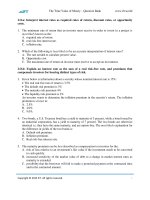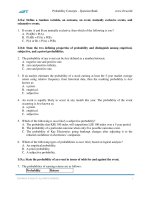CFA 2018 quest bank r41 risk management an introduction q bank
Bạn đang xem bản rút gọn của tài liệu. Xem và tải ngay bản đầy đủ của tài liệu tại đây (238.74 KB, 11 trang )
Risk Management: An Introduction – Question Bank
www.ift.world
LO.a: Define risk management.
1. Business and investing are about allocating resources and capital to chosen:
A. risks.
B. capital gains.
C. return.
2. Which of the following may be controlled by an investor?
A. Risk.
B. Raw returns.
C. Risk-adjusted returns.
3. Risk is all of the uncertain environmental variables that lead to:
A. coherence.
B. variability.
C. predictability.
4. Analyst 1: Risk management is the process by which an organization or individual defines
the level of risk to be taken, measures the level of risk being taken, and adjusts the latter
toward the former, with the goal of maximizing the company’s or portfolio’s value or the
individual’s overall satisfaction, or utility.
Analyst 2: Risk management is the process where a risk manager not only understands the
effect of environmental circumstances on the business, but also knows that he cannot do
anything about it.
Which analyst’s statement is most likely correct?
A. Analyst A.
B. Analyst B.
C. Both.
5. The ―Doctrine of No Surprises‖ states that:
A. risk managers are expected to predict risks.
B. the effect of the outcome of a predictable or an unpredictable event would not
surprise the risk manager and the effect would have been quantified and considered in
advance.
C. the effect of the outcome of a predictable or an unpredictable event would not
surprise the risk manager, but it would be difficult to quantify it in advance.
6. Bank XYZ has invested 80% of its portfolio in real estate in the beginning of 2012. In 2013,
real estate prices fall considerably. Given the unpredictable nature of this event, which of the
following statements is least likely accurate about the action taken by a good risk manager?
A good risk manager:
A. would not have predicted significant defaults on the bank’s real estate securities.
B. would actively help the bank decide on the exposure it should have in real estate
securities and quantify the potential losses of such a crisis.
C. is expected to prepare the organization for such a crisis through stress testing and
scenario analysis.
Risk Management: An Introduction – Question Bank
www.ift.world
7. The least likely goal of risk management is to:
A. measure risk exposures.
B. minimize exposure to risk.
C. define the level of risk appetite.
8. Which of the following statements best describe risk management in the case of individuals?
Risk management is:
A. maximizing utility while bearing a tolerable level of risk.
B. maximizing utility while avoiding exposure to risks.
C. hedging risk exposures.
LO.b: Describe features of a risk management framework.
9. The process of risk management includes:
A. minimizing risk.
B. maximizing returns.
C. defining and measuring risks being taken.
10. The element of a risk management framework that sets the overall context for risk
management in an organization is:
A. governance.
B. risk infrastructure.
C. policies and processes.
11. The element of risk management that most likely makes up the analytical component of the
process is:
A. communication.
B. risk governance.
C. risk identification and measurement.
12. The element of risk management which involves action when risk exposures are found to be
out of line with risk tolerance is:
A. risk governance.
B. risk identification and measurement.
C. risk monitoring, mitigation, and management.
13. The factors a risk management framework should address include all of the following except:
A. communications.
B. names of responsible individuals.
C. policies and processes.
14. Which of the following is the correct sequence of events for risk governance and
management that focuses on the entire enterprise? Establishing:
A. risk tolerance, then risk budgeting, and then risk exposures.
B. risk exposures, then risk tolerance, and then risk budgeting.
C. risk budgeting, then risk exposures, and then risk tolerance.
Risk Management: An Introduction – Question Bank
www.ift.world
LO.c: Define risk governance and describe elements of effective risk governance.
15. Which of the following approaches is the most consistent one with an enterprise view of risk
governance?
A. Trying to achieve the highest possible risk-adjusted return on a company’s pension
fund’s assets.
B. Create strategic planning processes at the business unit level for the enterprise.
C. Considering an organization’s risk tolerance when developing its asset allocation.
16. Which of the following statements about risk tolerance is most accurate?
A. The organization’s risk tolerance is a measure of the losses the organization is willing
to experience.
B. Risk tolerance is best discussed ex post, when awareness of risk is heightened.
C. The risk tolerance discussion focuses on the actions the management will take to
minimize losses.
17. Risk governance:
A. defines the qualitative assessment and evaluation of potential sources of risk in an
organization.
B. aligns risk management activities with the goals of the overall enterprise.
C. delegates responsibility for risk management to all levels of the organization’s
hierarchy.
18. Which of the following is not consistent with a risk-budgeting approach to portfolio
management?
A. Allocating investments by their amount of underlying risk sources or factors.
B. Limiting the amount of money available to be spent on hedging strategies by each
portfolio manager.
C. Limiting the beta of the portfolio to 0.75.
19. Who would be the least appropriate for controlling the risk management function in a large
organization?
A. Chief financial officer.
B. Chief risk officer.
C. Risk management committee.
LO.d: Explain how risk tolerance affects risk management.
20. The extent to which the entity is willing to experience losses or opportunity costs and to fail
in meeting its objectives is known as:
A. Risk averseness.
B. Risk mitigation.
C. Risk tolerance.
21. Two students make the following statements:
Student 1: The risk tolerance decision begins with analysis of an ―inside‖ view and an
―outside‖ view. The first deals with the shortfalls in the internal environment of the
Risk Management: An Introduction – Question Bank
www.ift.world
organization that could lead to failure. The later deals with outside uncertain forces that the
organization is exposed to.
Student 2: The risk tolerance decision begins with analysis of a ―Proactive‖ view and a
―reactive‖ view. The first deals with outside uncertain forces that the organization is exposed
to. The later deals with the shortfalls in the internal environment of the organization that
could lead to failure.
Which student’s statement is most likely correct?
A. Student 1.
B. Student 2.
C. Both.
22. Which factor should most affect a company’s ability to tolerate risk?
A. The ability to respond dynamically to adverse events.
B. The competitive landscape.
C. The beliefs of the individual board members.
LO.e: Describe risk budgeting and its role in risk governance.
23. Which of the following statements best distinguishes risk tolerance from risk budgeting?
A. Risk tolerance focuses on the appetite for risk and what is and is not acceptable, while
risk budgeting has a more specific focus on how that risk is taken.
B. Risk budgeting focuses on the appetite for risk and what is and is not acceptable,
while risk tolerance has a more specific focus on how that risk is taken.
C. Risk budgeting focuses on how much risk an organization can tolerate, while risk
tolerance deals with actively distributing that risk.
24. Risk budgeting includes all of the following except:
A. quantifying tolerable risk by specific metrics.
B. determining the target return.
C. allocating a portfolio by some risk characteristics of the investments.
LO.f: Identify financial and non-financial sources of risk and describe how they may
interact.
25. Analyst 1: Market risk is the risk that arises from the movements in interest rates, stock
prices, exchange rates, and commodity prices. Credit risk is the risk of loss if one party fails
to pay an amount owed on an obligation, and liquidity risk is the risk of a significant
downward valuation adjustment when selling a financial asset.
Analyst 2: Credit risk is the risk that arises from the movements in interest rates stock prices,
exchange rates, and commodity prices. Liquidity risk is the risk of loss if one party fails to
pay an amount owed on an obligation, and market risk is the risk of a significant downward
valuation adjustment when selling a financial asset.
Analyst 3: Liquidity risk is the risk that arises from the movements in interest rates, stock
prices, exchange rates, and commodity prices. Credit risk is the risk of loss if one party fails
to pay an amount owed on an obligation, and market risk is the risk of a significant
downward valuation adjustment when selling a financial asset.
Which analyst’s statement is most likely correct?
Risk Management: An Introduction – Question Bank
www.ift.world
A. Analyst 1.
B. Analyst 2.
C. Analyst 3.
26. Statement 1: Financial risk originates from activity in the financial markets. Non-financial
risk originates from outside the financial markets.
Statement 2: Financial risk originates from the financial markets. Non-financial risk is the
risk that is hard to quantify and includes the risks related to the environment at large.
Statement 3: Financial and non-financial risks both originate from financial markets.
Which statement(s) is/are correct?
A. Statements 2 and 3.
B. Statement 1 and 2.
C. Statement 1 only.
27. An example of a non-financial risk is:
A. market risk.
B. credit risk.
C. settlement risk.
28. Which of the following is a financial risk?
A. Legal risk.
B. Market risk.
C. Operational risk.
29. Which of the following best describes an example of interactions among risks?
A. Political events cause a decline in economic conditions and an increase in credit
spreads.
B. A stock in United States declines at the same time as a stock in Germany declines.
C. A market decline makes a derivative counterparty less creditworthy, while causing it
to owe more money on that derivative contract.
30. Which of the following best describes a financial risk?
A. The risk that regulations will make a transaction illegal.
B. The risk that interest rates will increase.
C. The risk of an individual trading without limits or controls.
31. Which of the following is not an example of model risk?
A. Using the one-year risk-free rate to discount the face value of a one-year government
bond.
B. Assuming the tails of a returns distribution are thin when they are, in fact, fat.
C. Using standard deviation to measure risk when the returns distribution is asymmetric.
32. Which of the following is the risk that arises when it becomes difficult to sell a security in a
highly stressed market?
A. Liquidity risk.
Risk Management: An Introduction – Question Bank
www.ift.world
B. Credit risk.
C. Systemic risk.
33. The risks that individuals face based on mortality create which of the following problems?
A. Covariance risk associated with their human capital and their investment portfolios.
B. The risk of loss of income to their families.
C. The interacting effects of solvency risk and the risk of being taken advantage of by an
unscrupulous financial adviser.
LO.g: Describe methods for measuring and modifying risk exposures and factors to
consider in choosing among the methods.
34. Which of the following is most likely a risk driver from the perspective of an organization?
A. The probabilities of adverse events.
B. The statistical methods that measure risk.
C. Factors that influence macroeconomies and industries.
35. The concept that directly measures the risk of derivatives is:
A. Beta and standard deviation.
B. Probability.
C. Delta and gamma.
36. The best definition of value at risk is:
A. the expected loss if a counterparty defaults.
B. the maximum loss an organization would expect to incur over a holding period.
C. the minimum loss expected over a holding period a certain percentage of the time.
37. The methods commonly used to supplement VaR to measure the risk of extreme events is:
A. standard deviation.
B. loss given default.
C. scenario analysis and stress testing.
38. Which of the following statements is most likely accurate about insurable risks?
A. Insurable risks are less costly.
B. Insurable risks have smaller loss limits.
C. Insurable risks are typically diversifiable by the insurer.
39. If a company has a one-day 10% Value at Risk of $1 million, this means:
A. 10% of the time the firm is expected to lose at least $1 million in one day.
B. 90% of the time the firm is expected to lose at least $1 million in one day.
C. 10% of the time the firm is expected to lose no more than $1 million in one day.
40. Which of the following is the best option for an entity choosing to accept a risk exposure?
A. Establish a reserve fund to cover losses.
B. Buy insurance.
C. Enter into a derivative contract.
Risk Management: An Introduction – Question Bank
41. The choice of risk-modification method is based on:
A. maximizing returns at the lowest cost.
B. how costs versus benefits weigh against the entity’s risk tolerance.
C. minimizing risk at the lowest cost.
www.ift.world
Risk Management: An Introduction – Question Bank
www.ift.world
Solutions
1. A is correct. Business and investing are about allocating resources and capital to the chosen
risks.
2. A is correct. Many decision makers focus on return, which is not something that is easily
controlled, as opposed to risk, or exposure to risk, which may actually be managed or
controlled.
3. B is correct. Risk is related to variability.
4. A is correct. Analyst A is correct because risk management covers understanding the level of
bearable risk, measure the risk taken, adjust the bearable risk with the level of risk taken,
while keeping in view the value maximization and utility of the company portfolio.
5. B is correct. The ―Doctrine of No Surprises‖ states that the effect of the outcome of a
predictable or an unpredictable event would not surprise the risk manager and the effect
would have been quantified and considered in advance.
6. A is correct. The other two statements are what a good risk manager would do. Even though
the real estate crisis was unpredictable, a good risk manager is expected to prepare for such
crises. A good risk manager is also expected to continuously report in advance on the
potential impact of this sizable risk exposure.
7. B is correct. The definition of risk management includes both defining the level of risk
desired and measuring the level of risk taken. Risk management means taking risks actively
and in the best, most value-added way possible and is not about minimizing risks.
8. A is correct. For individuals, risk management concerns maximizing utility while taking risk
consistent with individual’s level of risk tolerance.
9. C is correct. Risks need to be defined and measured so as to be consistent with the entity’s
chosen level of risk tolerance and target for returns or other outcomes.
10. A is correct. Governance is the element of the risk management framework that is the toplevel foundation for risk management. Although policies, procedures, and infrastructure are
necessary to implement a risk management framework, it is governance that provides the
overall context for an organization’s risk management.
11. C is correct. Risk identification and measurement is the quantitative part of the process. It
involves identifying the risks and summarizing their potential quantitative impact.
Communication and risk governance are largely qualitative.
12. C is correct. Risk monitoring, mitigation, and management require recognizing and taking
action when these (risk exposure and risk tolerance) are not in line. Risk governance involves
setting the risk tolerance. Risk identification and measurement involves identifying and
measuring the risk exposures.
Risk Management: An Introduction – Question Bank
www.ift.world
13. B is correct. While risk infrastructure, which a risk management framework must address,
refers to the people and systems required to track risk exposures, there is no requirement to
actually name the responsible individuals.
14. A is correct. In establishing a risk management system, determining risk tolerance must
happen before specific risks can be accepted or reduced. Risk tolerance defines the appetite
for risk. Risk budgeting determine how or where the risk is taken and quantifies the tolerable
risk by specific metrics. Risk exposures can then be measured and compared against the
acceptable risk.
15. C is correct. The enterprise view of risk management considers the organization as a whole—
its goals, value, and risk tolerance. It is not about strategies or risks at the individual business
line level.
16. A is correct. Risk tolerance identifies the extent to which the organization is willing to
experience losses or opportunity costs and fail in meeting its objectives. It is best discussed
before a crisis (ex ante) and is primarily a risk governance or oversight issue at the board
level, not a management or tactical one.
17. B is correct. Risk governance is the top-down process that defines risk tolerance, provides
risk oversight and guidance to align risk with enterprise goals.
18. B is correct. Risk budgeting is any means of allocating a portfolio by some risk
characteristics of the investments. This approach could be a strict limit on beta or some other
risk measure or an approach that uses risk classes or factors to allocate investments. Risk
budgeting does not require nor prohibit hedging, although hedging is available as an
implementation tool to support risk budgeting and overall risk governance.
19. A is correct. A chief risk officer or a risk management committee is an individual or group
that focuses primarily on risk management. A chief financial officer, may supervise a CRO,
and would likely have some involvement in a risk management committee, but a CFO has
broader responsibilities, cannot provide the specialization and exclusive attention to risk
management that is necessary in a large organization.
20. C. is correct. The extent to which the entity is willing to experience losses or opportunity
costs and to fail in meeting its objectives is known as risk tolerance.
21. A is correct.
22. A is correct. A company’s ability to adapt quickly to adverse events may allow for a higher
risk tolerance. There are other factors, such as beliefs of board members and a stable market
environment, which may but should not affect risk tolerance.
23. A is correct. Risk tolerance and risk budgeting are different form each other because risk
tolerance focuses on the appetite for risk and what is and is not acceptable, risk budgeting has
a more specific focus on how that risk is taken.
Risk Management: An Introduction – Question Bank
www.ift.world
24. B is correct. Risk budgeting does not include determining the target return. Risk budgeting
quantifies and allocates the tolerable risk by specific metrics.
25. A is correct. Market risk is the risk that arises from the movements in interest rates stock
prices, exchange rates, and commodity prices. Credit risk is the risk of loss if one party fails
to pay an amount owed on an obligation, and liquidity risk is the risk of a significant
downward valuation adjustment when selling a financial asset.
26. B is correct. Financial risk originates form the financial markets. Non-financial risk is the
risk that is hard to quantify and includes the risks related actions within an entity, or from
external origins, such as the environment, the community, regulators, politicians, suppliers,
and customers.
27. C is correct. Settlement risk is related to default risk, but deals with the timing of payments
rather than the risk of default.
28. B is correct. Examples of non-financial risks include legal risk, settlement risk, operational
risk, regulatory risk, tax risk, model risk. Credit risk, market risk, and liquidity risk are
financial risks. Operational risk is the only risk listed that is considered non-financial, even
though it may have financial consequences.
29. C is correct. The conditions mentioned in A are directly linked and hence do not represent an
interaction of risks. B indicates a global decline in equity values which is also not an
interaction of risk. C represents an interaction between market risk and credit risk.
30. B is correct because this risk arises from the financial markets.
31. A is correct. The risk-free rate is generally the appropriate rate to use in discounting
government bonds. Although government bonds are generally default free, their returns are
certainly risky. Assuming a returns distribution has thin tails when it does not and assuming
symmetry in an asymmetric distribution are both forms of model risk.
32. A is correct. Securities vary highly in how liquid they are. Those with low liquidity are those
for which either the number of agents willing to invest or the amount of capital these agents
are willing to invest is limited. When markets are stressed, these limited number of investors
or small amount of capital dry up, leading to the inability to sell the security at any price the
seller feels is reasonable. Systemic risk is the risk of failure of the entire financial system and
a much broader risk than liquidity risk. Credit risk is the risk of loss caused by a
counterparty’s or debtor’s failure to make a promised payment.
33. B is correct. The uncertainty about death creates two risks: mortality risk and longevity risk.
The mortality risk (risk of dying relatively young) is manifested by a termination of the
income stream generated by the person. In contrast, longevity risk is the risk of outliving
one’s financial resources.
Risk Management: An Introduction – Question Bank
www.ift.world
34. C is correct. Risks (and risk drivers) arise from fundamental factors in macroeconomies and
industries.
35. C is correct. Delta and gamma are measures of the movement in an option price, given a
movement in the underlying. The other answers can reflect some elements of derivatives risk,
but they are not direct measures of the risk.
36. C is correct. VaR measures a minimum loss expected over a holding period a certain
percentage of the time. It is not an expected loss nor does it reflect the maximum possible
loss, which is the entire equity of the organization.
37. C is correct. Scenario analysis and stress testing both examine the performance of a portfolio
subject to extreme events. The other two answers are metrics used in portfolio analysis but
are not typically associated with extreme events.
38. C is correct. Insurance works by pooling risks. It is not necessarily less costly than
derivatives nor does it have lower loss limits.
39. A is correct. The VaR measure indicates the probability of a loss of at least a certain level in
a time period.
40. A is correct. Risk acceptance is similar to self-insurance. An entity choosing to self-insure
may set up a reserve fund to cover losses. Buying insurance is a form of risk transfer and
using derivatives is a form of risk-shifting, not risk acceptance.
41. B is correct. Among the risk-modification methods of risk avoidance, risk acceptance, risk
transfer, and risk shifting none has a clear advantage. One must weigh benefits and costs in
light of the firm’s risk tolerance when choosing the method to use.









